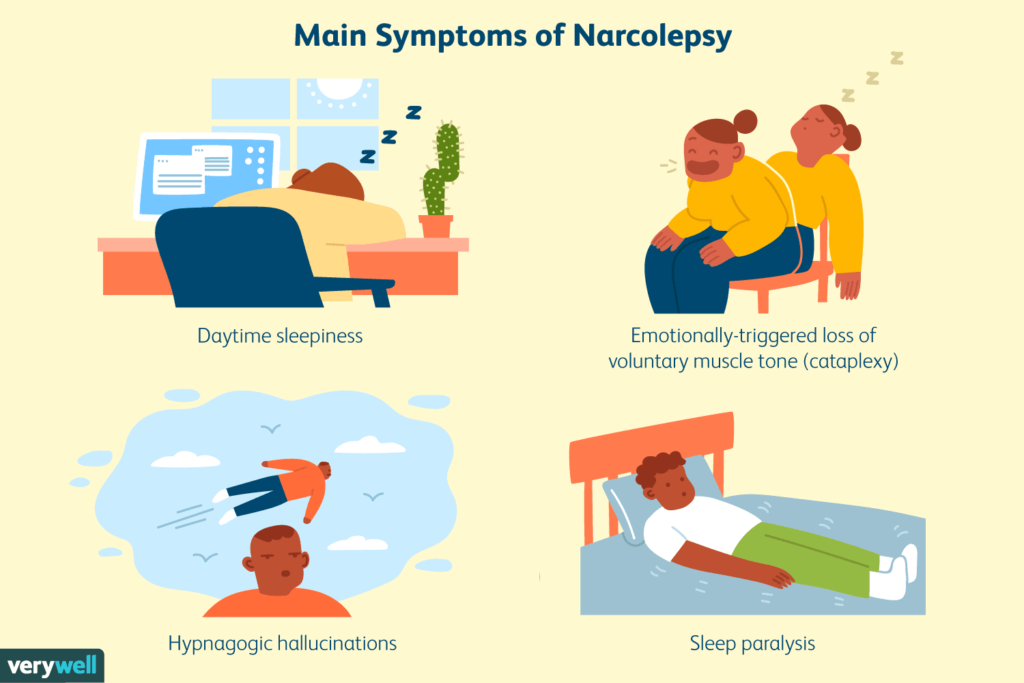A Quick Guide
Narcolepsy is a complicated sleep condition characterized by excessive daytime sleepiness, cataplexy, sleep paralysis, and hallucinations. A full evaluation is required to diagnose narcolepsy, and while there is no cure, medication options, lifestyle changes, and safety precautions can help individuals manage their symptoms effectively.
What is Narcolepsy?
Narcolepsy is a neurological condition in which the brain’s capacity to control sleep-wake cycles is impaired. The symptoms of this condition include extreme daytime sleepiness, hallucinations, and an abrupt loss of muscular tone (cataplexy). Narcolepsy patients frequently have interrupted sleep patterns, which can have a substantial influence on their quality of life and everyday functioning.
Causes of Narcolepsy
The specific cause of narcolepsy is yet unknown. However, research reveals that a combination of hereditary and environmental variables may be involved. One of the fundamental causes of narcolepsy is a lack of hypocretin, a brain hormone that plays an important role in increasing alertness. This deficit is thought to be caused by an autoimmune reaction that damages the brain’s hypocretin-producing cells.
Common Symptoms
Narcolepsy is characterized by many distinctive symptoms that vary in intensity and frequency between people. The following are the most prevalent symptoms:

Excessive Daytime drowsiness: People with narcolepsy frequently have a continuous and overpowering sense of drowsiness throughout the day. This can make it difficult to stay awake, especially during monotonous or inactive activities.
Cataplexy: Cataplexy is an abrupt lack of muscle control caused by intense emotions such as laughing, surprise, or anger. It might range from a brief weakness of the facial muscles to a total collapse of the body.
Sleep paralysis: A brief incapacity to move or speak after falling asleep or waking up is referred to as sleep paralysis. It is often accompanied by vivid hallucinations and a feeling of pressure in the chest, which can cause feelings of anxiety or panic.
Hypnagogic and hypnopompic hallucinations: These occur during the transition from waking to sleep. People may have intense and frequently disturbing visual or auditory hallucinations that are difficult to discern from reality.
Nighttime Sleep Disruption: Narcoleptics frequently have altered nighttime patterns of sleep, including waking up frequently and having vivid dreams.
Diagnosis
Narcolepsy can be difficult to diagnose because its symptoms are similar to those of other sleep disorders. An in-depth examination is required, which may include the following:
Assessment of Medical History and Symptoms: The healthcare practitioner will go over the individual’s medical history and symptoms to look for patterns and assess if narcolepsy is likely.
Sleep Studies: Polysomnography and the Multiple Sleep Latency Test (MSLT) are two regularly used sleep studies to analyze sleep patterns and measure daytime tiredness. These tests aid in the identification of narcolepsy-related abnormalities in the sleep-wake cycle.
Hypocretin Level Testing: A CSF fluid sample may be collected in some patients to evaluate the quantity of hypocretin-1, which may support the diagnosis of narcolepsy with cataplexy.
Watch: [What is Narcolepsy?]
Treatment and Management
While there is currently no cure for narcolepsy, numerous options for treatment can help manage the disorder’s symptoms and improve the quality of life for those who suffer from it. The treatment strategy could include a combination of the following:
Medication: To increase wakefulness and lessen daytime sleepiness, stimulant drugs like modafinil and armodafinil are often prescribed. Antidepressants, such as selective serotonin reuptake inhibitors (SSRIs) or serotonin-norepinephrine reuptake inhibitors (SNRIs), can help manage cataplexy and enhance overnight sleep.
Scheduled Naps: Taking brief naps throughout the day might help relieve daytime tiredness and increase attentiveness.
Support and Education: Participating in support groups or seeking counseling can provide useful resources, coping skills, and emotional support to individuals and their families.
Life Changes for Narcolepsy Management
Living with narcolepsy necessitates some lifestyle changes in order to manage symptoms and improve general well-being. Here are some crucial lifestyle modifications that can help:
Maintain a consistent Sleep schedule: Having a constant sleep schedule can help control the sleep-wake cycle. Even on weekends, going to bed and waking up at the same time every day can enhance sleep quality and prevent excessive daytime sleepiness.
Make Your Environment Sleep-Friendly: Make sure your bedroom is sleep-friendly. Maintain a cool, dark, and quiet environment in the room. To block out any unwanted light, use comfy bedding and think about using blackout curtains or a sleep mask.
Avoid Stimulants: Stimulants such as caffeine and nicotine can disturb sleep patterns and increase symptoms. Limit or avoid consuming these substances, especially close to bedtime.
Regular Physical Activity: Engaging in daily exercise can assist improve overall sleep quality and boost wakefulness during the day. However, it is vital to avoid vigorous activity too near bedtime, as it could cause problems with sleep.
Strategic napping: Strategic napping may help combat excessive daytime exhaustion. Short 20-minute power naps might deliver a rapid boost of energy and attentiveness. However, avoid resting too close to bedtime because it may disrupt your nightly sleep.
Safety Precautions
Because narcolepsy symptoms are unpredictable, taking safety precautions is critical to avoid accidents and ensure personal well-being. Consider the following safety precautions:
Avoid Driving While Sleepy: Sleepiness can impair driving abilities and raise the chance of an accident. If you have a sleep attack or feel very drowsy while driving, pull over and take a nap or arrange alternate transportation.
Exercise Caution Around Potentially Dangerous Activities: Performing tasks that call for heightened vigilance, such as operating large machinery or working at heights, should be undertaken with caution. To avoid accidents, make sure you get enough rest and take breaks as needed.
Establish a nighttime ritual and Practise excellent Sleep Hygiene: Establishing a nighttime ritual and practicing excellent sleep hygiene will help you sleep better. This involves avoiding electronic gadgets before bed, developing a calming nighttime ritual, and creating a sleep environment that is comfortable.
Communicate with Family and Friends: Inform your family and friends about narcolepsy and its signs and symptoms so that they are able to assist you during bouts of cataplexy or other symptoms. Giving them information can also assist them in recognizing and responding correctly during episodes.
Remember that everyone’s experience with narcolepsy is unique. So working together with healthcare specialists to build a personalized management strategy that meets your specific needs is essential.
Important Takeaways
Narcolepsy is a complicated sleep disorder that can have an important impact on a person’s everyday life. While its precise cause is unknown, understanding the symptoms, diagnosis process, and available treatment choices can help people with narcolepsy manage their condition more effectively.



 Meditation and ADHD: Does it work & How to get started?
Meditation and ADHD: Does it work & How to get started?  Weaponized incompetence: what it is and how to detect it
Weaponized incompetence: what it is and how to detect it  ADHD & Insomnia: What You Need To Know
ADHD & Insomnia: What You Need To Know  The Hidden Struggles of Undiagnosed ADHD in Adults
The Hidden Struggles of Undiagnosed ADHD in Adults  Amnesia: Understanding Its Causes, Types, & Treatment
Amnesia: Understanding Its Causes, Types, & Treatment  Understanding Echolalia in ADHD: Causes, Symptoms, & Strategies for Support
Understanding Echolalia in ADHD: Causes, Symptoms, & Strategies for Support